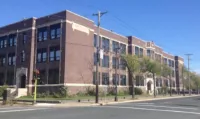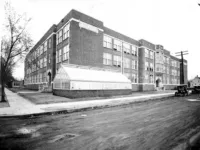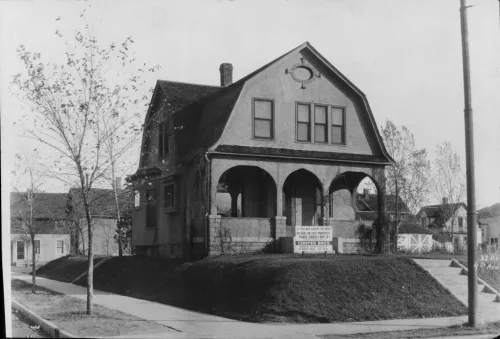Share what you know,
and discover more.
Share what you know,
and discover more.
Jun 01, 1922

-

- Charmaine Bantugan
310 East 38th Street, Minneapolis, MN, USA
This building is currently home to the Sabathani Community Center. Prior to that, it operated as Bryant Junior High School until 1978. It is located in the Central neighborhood in south Minneapolis, MN. History This building has two distinct histories both tied to the Central neighborhood. The first being it's place as a junior high school that at one point served residents in what was the center of the black population in south Minneapolis. Population changes and relocation of many families, black families included (many of whom moved to north Minneapolis and the suburbs) resulted the wide-spread consolidation and closing of many public schools in the city. It was with the closing of this school that it began its second life as a community center housing many non-profit and government organizations that are actively engaged in the Central neighborhood and Twin Cities community. Building Design This three-story masonry and wood structure was constructed 1922-1923. The building originally sat on 6.26 acres shared with Warrington Elementary School. The building was equipped with the following: 21 classrooms, 2 science lab, 2 art rooms, a metal shop, a wood working shop, a drafting room, an electric shop, a graphic arts studio, 2 food laboratories, a clothing laboratories, a typing room, a male gym, a female gym, a swimming pool, a band room, a music room, 2 special education rooms, and a remedial reading room. The design, similar to many area high schools and shared by 3 additional junior high schools built in the 1920’s, allowed for an optimum capacity of 830 students and a rate capacity of 1,040 students. Renovations In 1963, a survey was conducted to determine want renovations would be needed to modernize the building. Many of the improvements that were needed were things like updating equipment and furniture, improving acoustic in music rooms, painting, relocating the graphic art dark room and instrumental music room, and suggested the need for additional acreage for a playground area and additional parking. Bryant Junior High School 1922-1979 Attendance in Minneapolis Public Schools rose from 54,000 in 1916 to approximately 88,000 in 1930. This population increase resulted in a building boom in the 1920’s, which produced 30 new schools one of which was Bryant Junior High School. The massive project was overseen by the Bureau of Buildings, formally The Architectural Division, and was headed up by engineer Edward H. Enger. The school itself is named after William Cullen Bryant, and American writer born in 1794. The school was the third in a series of schools named for the author, the first being a 3-room school house built in 1885 at 38th St. and 4th Ave. S. and the second built in 1898 at 3707 3rd Ave. S. Elementary schools that fed into Bryant were Lyndale, Agassiz, Barton, Field, Warrington, Clinton, Mann, Bancroft, and Northrop. Even with nine feeder schools, it didn’t protect the school from population changes. With more and more families locating to the suburbs in the 1970’s, Minneapolis Public Schools was force to close and consolidate many neighborhood schools. Bryant Junior High closed was one the schools selected, closing its doors in 1978. After closing its doors, the school sat vacant for about a year, at one point the city considered bulldozing the school and selling off the property for development. During the summer of 1979, Sabathani Community Center proposed to lease the property. The Minneapolis School Board had no interest in acting as a landlord for the facility but there was a push from the local community for Sabathani to use the facilities. Rather than leasing, the school board sold the property to Sabathani for $72,000. The deal provided Sabathani with a new site to grow into and provided the city with some revenue. Sabathani Community Center 1979-Present Since its inception, Sabathani Community Center has played an active role in what was the predominately black Central neighborhood. Local residents and members of the Sabathani Baptist Church established the Sabathani Community Center in 1966. Created originally to provide recreation for neighborhood children, they quickly outgrew the church basement in which they were originally housed as they become more active with community issues. Following a large outpouring of support and lobbying from the local community, the city of Minneapolis and Minneapolis Public Schools sold the former school to Sabathani for $72,500. Sabathani settled into the former school in 1979. Today, not only has the Central neighborhood changed, but so has Sabathani's place in it. The neighborhood that was once home to south Minneapolis' black population has, since the 1990's, seen an many Latino families settle in the neighborhood. Sabathani has expanded their mission from providing services to mainly black families and youth to providing services in everything from adult education, family counseling services, and other charity organization. They lease building space to several organizations; many of the current tenants, such as Out Front MN GBLTG, MNIC Adult Education, Somali Family & Youth Services, are non-profit organizations that are actively involved within the Twin Cities community. They continue to reflect the needs of the community in which they are located. First Owner: Minneapolis Public Schools This place is part of the ARCH5670 Class Project
310 East 38th Street, Minneapolis, MN, USA
This building is currently home to the Sabathani Community Center. Prior to that, it operated as Bryant Junior High School until 1978. It is located in the Central neighborhood in south Minneapolis, MN. History This building has two distinct histories both tied to the Central neighborhood. The first being it's place as a junior high school that at one point served residents in what was the center of the black population in south Minneapolis. Population changes and relocation of many families, black families included (many of whom moved to north Minneapolis and the suburbs) resulted the wide-spread consolidation and closing of many public schools in the city. It was with the closing of this school that it began its second life as a community center housing many non-profit and government organizations that are actively engaged in the Central neighborhood and Twin Cities community. Building Design This three-story masonry and wood structure was constructed 1922-1923. The building originally sat on 6.26 acres shared with Warrington Elementary School. The building was equipped with the following: 21 classrooms, 2 science lab, 2 art rooms, a metal shop, a wood working shop, a drafting room, an electric shop, a graphic arts studio, 2 food laboratories, a clothing laboratories, a typing room, a male gym, a female gym, a swimming pool, a band room, a music room, 2 special education rooms, and a remedial reading room. The design, similar to many area high schools and shared by 3 additional junior high schools built in the 1920’s, allowed for an optimum capacity of 830 students and a rate capacity of 1,040 students. Renovations In 1963, a survey was conducted to determine want renovations would be needed to modernize the building. Many of the improvements that were needed were things like updating equipment and furniture, improving acoustic in music rooms, painting, relocating the graphic art dark room and instrumental music room, and suggested the need for additional acreage for a playground area and additional parking. Bryant Junior High School 1922-1979 Attendance in Minneapolis Public Schools rose from 54,000 in 1916 to approximately 88,000 in 1930. This population increase resulted in a building boom in the 1920’s, which produced 30 new schools one of which was Bryant Junior High School. The massive project was overseen by the Bureau of Buildings, formally The Architectural Division, and was headed up by engineer Edward H. Enger. The school itself is named after William Cullen Bryant, and American writer born in 1794. The school was the third in a series of schools named for the author, the first being a 3-room school house built in 1885 at 38th St. and 4th Ave. S. and the second built in 1898 at 3707 3rd Ave. S. Elementary schools that fed into Bryant were Lyndale, Agassiz, Barton, Field, Warrington, Clinton, Mann, Bancroft, and Northrop. Even with nine feeder schools, it didn’t protect the school from population changes. With more and more families locating to the suburbs in the 1970’s, Minneapolis Public Schools was force to close and consolidate many neighborhood schools. Bryant Junior High closed was one the schools selected, closing its doors in 1978. After closing its doors, the school sat vacant for about a year, at one point the city considered bulldozing the school and selling off the property for development. During the summer of 1979, Sabathani Community Center proposed to lease the property. The Minneapolis School Board had no interest in acting as a landlord for the facility but there was a push from the local community for Sabathani to use the facilities. Rather than leasing, the school board sold the property to Sabathani for $72,000. The deal provided Sabathani with a new site to grow into and provided the city with some revenue. Sabathani Community Center 1979-Present Since its inception, Sabathani Community Center has played an active role in what was the predominately black Central neighborhood. Local residents and members of the Sabathani Baptist Church established the Sabathani Community Center in 1966. Created originally to provide recreation for neighborhood children, they quickly outgrew the church basement in which they were originally housed as they become more active with community issues. Following a large outpouring of support and lobbying from the local community, the city of Minneapolis and Minneapolis Public Schools sold the former school to Sabathani for $72,500. Sabathani settled into the former school in 1979. Today, not only has the Central neighborhood changed, but so has Sabathani's place in it. The neighborhood that was once home to south Minneapolis' black population has, since the 1990's, seen an many Latino families settle in the neighborhood. Sabathani has expanded their mission from providing services to mainly black families and youth to providing services in everything from adult education, family counseling services, and other charity organization. They lease building space to several organizations; many of the current tenants, such as Out Front MN GBLTG, MNIC Adult Education, Somali Family & Youth Services, are non-profit organizations that are actively involved within the Twin Cities community. They continue to reflect the needs of the community in which they are located. First Owner: Minneapolis Public Schools This place is part of the ARCH5670 Class Project
Jun 01, 1922
310 East 38th Street, Minneapolis, MN, USA
This building is currently home to the Sabathani Community Center. Prior to that, it operated as Bryant Junior High School until 1978. It is located in the Central neighborhood in south Minneapolis, MN.History
This building has two distinct histories both tied to the Central neighborhood. The first being it's place as a junior high school that at one point served residents in what was the center of the black population in south Minneapolis. Population changes and relocation of many families, black families included (many of whom moved to north Minneapolis and the suburbs) resulted the wide-spread consolidation and closing of many public schools in the city. It was with the closing of this school that it began its second life as a community center housing many non-profit and government organizations that are actively engaged in the Central neighborhood and Twin Cities community.
Building Design
This three-story masonry and wood structure was constructed 1922-1923. The building originally sat on 6.26 acres shared with Warrington Elementary School. The building was equipped with the following: 21 classrooms, 2 science lab, 2 art rooms, a metal shop, a wood working shop, a drafting room, an electric shop, a graphic arts studio, 2 food laboratories, a clothing laboratories, a typing room, a male gym, a female gym, a swimming pool, a band room, a music room, 2 special education rooms, and a remedial reading room. The design, similar to many area high schools and shared by 3 additional junior high schools built in the 1920’s, allowed for an optimum capacity of 830 students and a rate capacity of 1,040 students.
Renovations
In 1963, a survey was conducted to determine want renovations would be needed to modernize the building. Many of the improvements that were needed were things like updating equipment and furniture, improving acoustic in music rooms, painting, relocating the graphic art dark room and instrumental music room, and suggested the need for additional acreage for a playground area and additional parking.
Bryant Junior High School 1922-1979
Attendance in Minneapolis Public Schools rose from 54,000 in 1916 to approximately 88,000 in 1930. This population increase resulted in a building boom in the 1920’s, which produced 30 new schools one of which was Bryant Junior High School. The massive project was overseen by the Bureau of Buildings, formally The Architectural Division, and was headed up by engineer Edward H. Enger.
The school itself is named after William Cullen Bryant, and American writer born in 1794. The school was the third in a series of schools named for the author, the first being a 3-room school house built in 1885 at 38th St. and 4th Ave. S. and the second built in 1898 at 3707 3rd Ave. S.
Elementary schools that fed into Bryant were Lyndale, Agassiz, Barton, Field, Warrington, Clinton, Mann, Bancroft, and Northrop. Even with nine feeder schools, it didn’t protect the school from population changes. With more and more families locating to the suburbs in the 1970’s, Minneapolis Public Schools was force to close and consolidate many neighborhood schools. Bryant Junior High closed was one the schools selected, closing its doors in 1978.
After closing its doors, the school sat vacant for about a year, at one point the city considered bulldozing the school and selling off the property for development. During the summer of 1979, Sabathani Community Center proposed to lease the property. The Minneapolis School Board had no interest in acting as a landlord for the facility but there was a push from the local community for Sabathani to use the facilities. Rather than leasing, the school board sold the property to Sabathani for $72,000. The deal provided Sabathani with a new site to grow into and provided the city with some revenue.
Sabathani Community Center 1979-Present
Since its inception, Sabathani Community Center has played an active role in what was the predominately black Central neighborhood. Local residents and members of the Sabathani Baptist Church established the Sabathani Community Center in 1966. Created originally to provide recreation for neighborhood children, they quickly outgrew the church basement in which they were originally housed as they become more active with community issues.
Following a large outpouring of support and lobbying from the local community, the city of Minneapolis and Minneapolis Public Schools sold the former school to Sabathani for $72,500. Sabathani settled into the former school in 1979.
Today, not only has the Central neighborhood changed, but so has Sabathani's place in it. The neighborhood that was once home to south Minneapolis' black population has, since the 1990's, seen an many Latino families settle in the neighborhood. Sabathani has expanded their mission from providing services to mainly black families and youth to providing services in everything from adult education, family counseling services, and other charity organization. They lease building space to several organizations; many of the current tenants, such as Out Front MN GBLTG, MNIC Adult Education, Somali Family & Youth Services, are non-profit organizations that are actively involved within the Twin Cities community. They continue to reflect the needs of the community in which they are located.
First Owner: Minneapolis Public Schools
This place is part of the ARCH5670 Class Project
Posted Date
Jun 15, 2022
Historical Record Date
Jun 01, 1922
Source Name
Placeography Org
Delete Story
Are you sure you want to delete this story?













